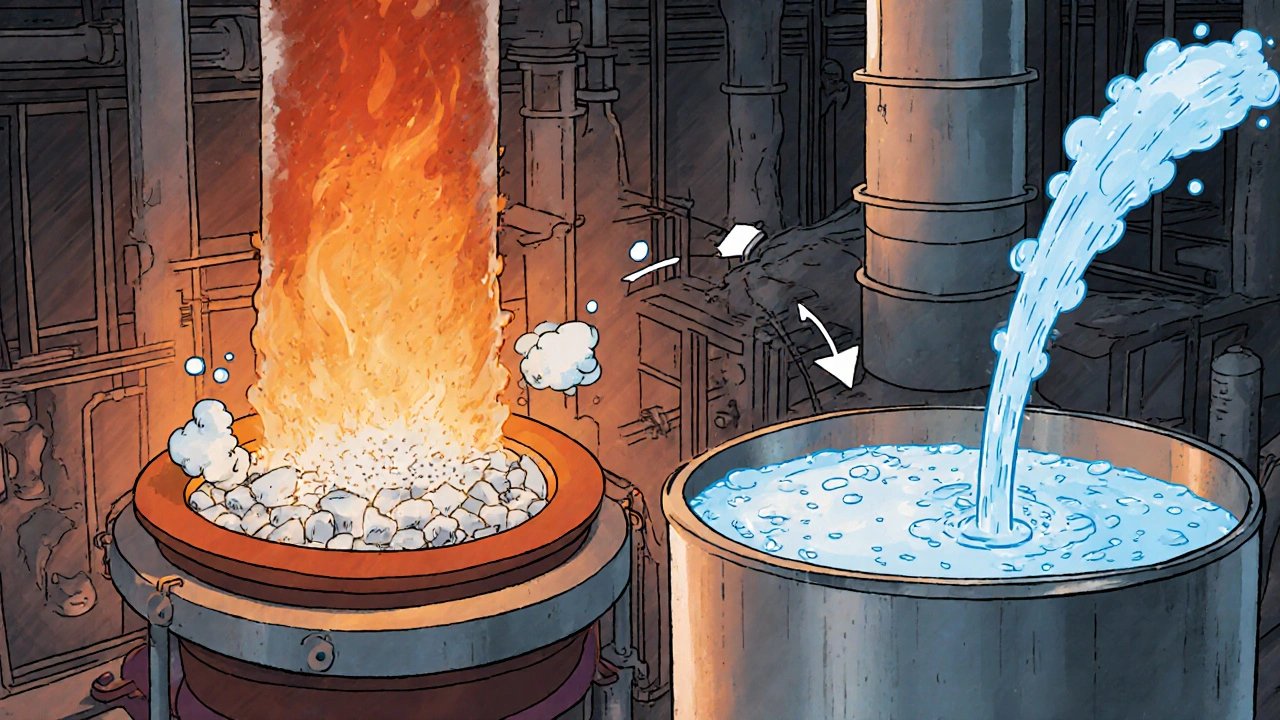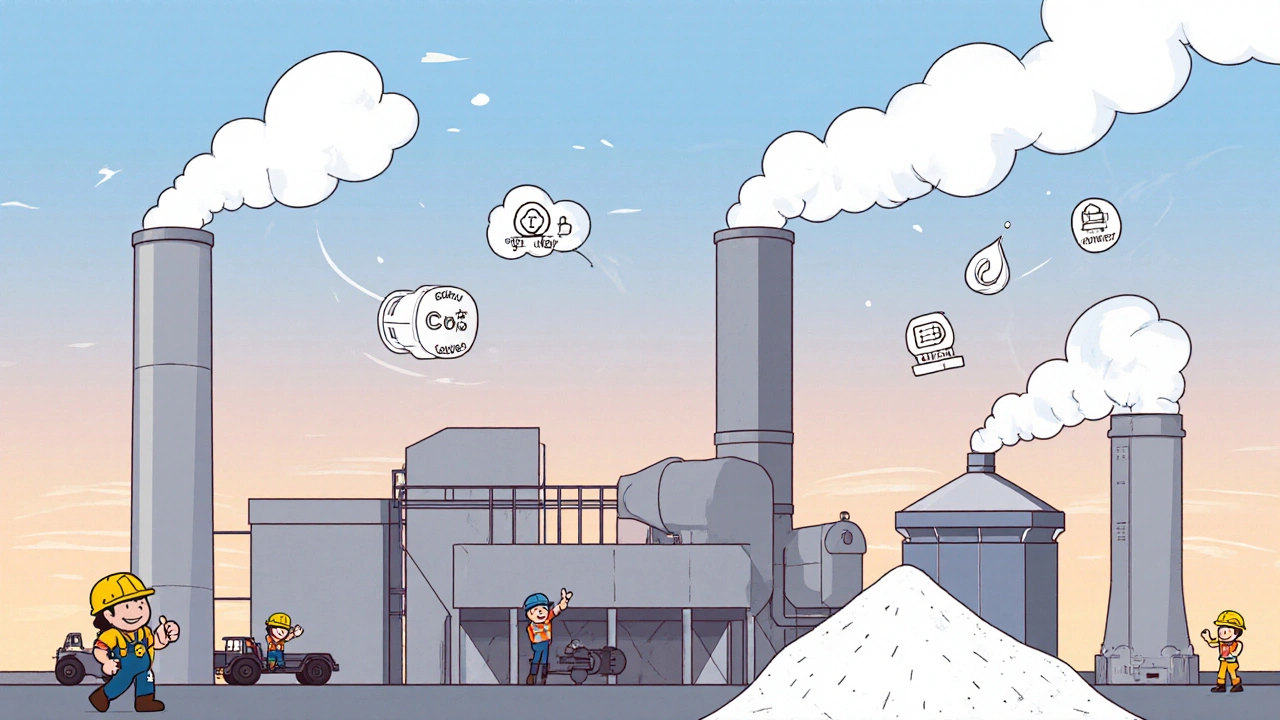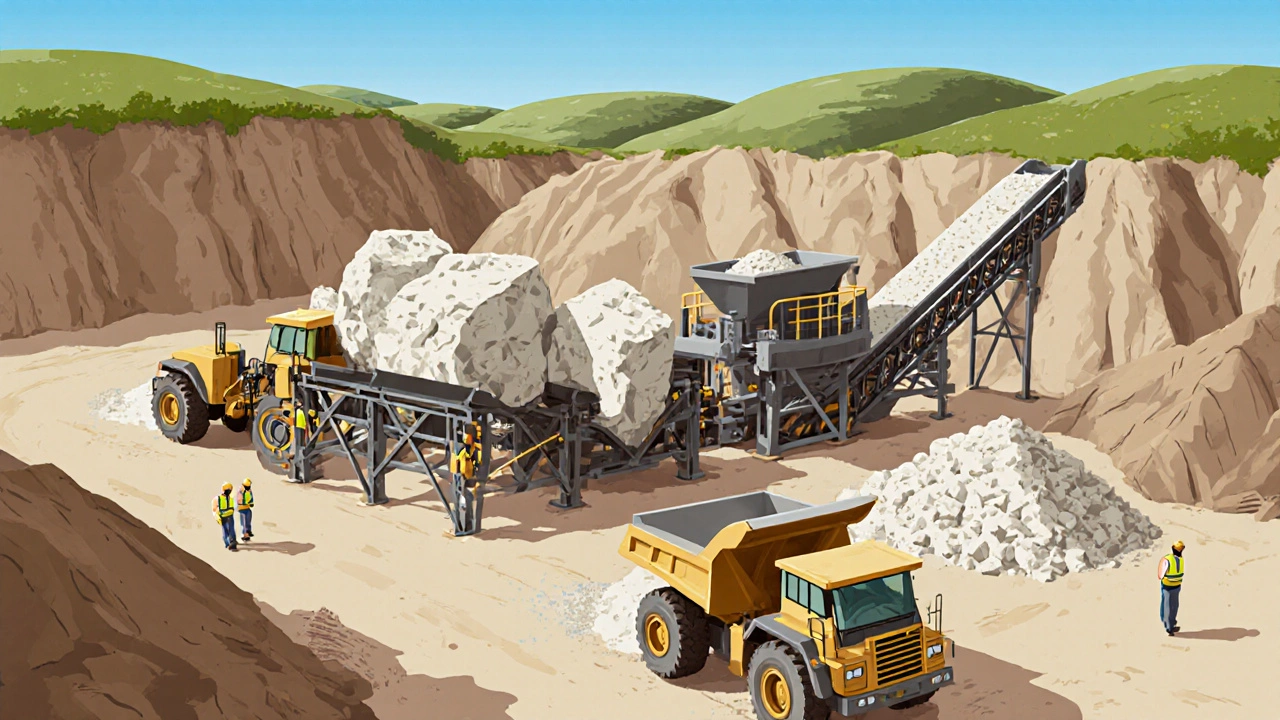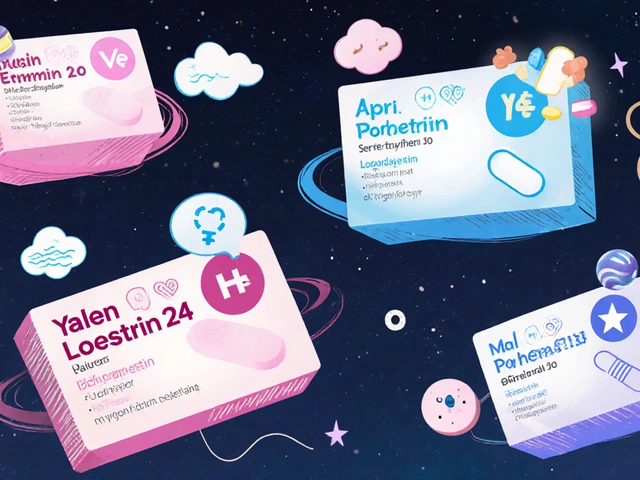Gypsum Production Calculator
How This Calculator Works
Based on industry data from the article, a 500 MW plant with 90% SO₂ removal produces approximately 250,000 tonnes of gypsum annually. The calculator uses a standard conversion factor to estimate production for your specific parameters.
Key Factors:
- Higher plant capacity increases production
- Greater SO₂ removal efficiency yields more gypsum
- Market value ranges from $30-$45 per tonne based on purity
When coal‑fired power plants or heavy industries try to curb sulfur emissions, the first thing they turn to is a reliable, cheap scrubber material. Calcium carbonate is a mineral that fits the bill perfectly, and its role in making modern desulfurization agents often goes unnoticed. This guide walks you through why calcium carbonate matters, how it’s transformed into a scrubber, and what you need to watch out for if you’re planning a plant upgrade.
What is Calcium Carbonate and Why Is It Popular?
Calcium carbonate (chemical formula CaCO3) is a natural compound found in limestone, marble, and chalk. Its abundance, low cost, and easy handling make it a staple across dozens of industries-from construction to food processing. In the context of flue‑gas desulfurization, its strength lies in a simple chemistry: when heated, it releases carbon dioxide and leaves behind calcium oxide (quicklime), a powerful alkaline that reacts with sulfur dioxide (SO2) to form harmless calcium sulfite or gypsum.
Desulfurization Agents: The Basics
Desulfurization agents are chemicals added to flue‑gas streams to capture sulfur oxides (SOx) before they exit the stack. The most common method, known as wet flue‑gas desulfurization (FGD), sprays a slurry of alkaline material into the gas stream. The alkaline component neutralizes the acidic SO2, producing a solid by‑product that can be sold as gypsum for drywall.
From Limestone to a Scrubber: The Production Process
- Mining and crushing: Limestone blocks are extracted and crushed into 1-5mm particles. The smaller size speeds up the later calcination step.
- Calcination: The crushed material is fed into a rotating kiln heated to 900-1000°C. The reaction CaCO3 → CaO + CO2 occurs, creating quicklime.
- Hydration: Quicklime is mixed with water, forming calcium hydroxide (slaked lime). This step is exothermic and requires careful temperature control.
- Slurry preparation: The slaked lime is blended with a small amount of gypsum or additives (e.g., magnesium oxide) to improve particle size distribution and prevent scaling.
- Application in FGD: The final slurry is pumped into the scrubber tower, where it reacts with SO2 to produce calcium sulfite, which later oxidizes to gypsum.
Each step adds cost, but the raw material-calcium carbonate-remains the cheapest part of the chain, often under $30 per tonne worldwide (2025 market data).
Advantages of Calcium Carbonate‑Based Agents
- Cost efficiency: Limestone is globally abundant. Even low‑grade deposits meet the purity requirements for FGD.
- By‑product value: The gypsum produced can be sold to the construction industry, offsetting operating expenses.
- Low toxicity: Unlike sodium hydroxide or ammonia, calcium carbonate poses minimal health hazards for plant workers.
- Simple logistics: Bulk transport by rail or ship is straightforward, and storage doesn’t require special containers.

Limitations and Pitfalls
- Temperature sensitivity: The calcination stage must stay within a narrow window; too low and conversion is incomplete, too high and you waste energy.
- Scaling: In wet FGD systems, calcium carbonate can precipitate prematurely, fouling heat exchangers.
- Impurities: High iron or silica content in the raw limestone can reduce the purity of the gypsum by‑product.
- Carbon footprint: The CO2 released during calcination adds to greenhouse gas emissions unless captured.
How Calcium Carbonate Stacks Up Against Alternatives
| Material | Typical Cost (USD/tonne 2025) | Reaction Efficiency with SO₂ | By‑product Value | Main Drawbacks |
|---|---|---|---|---|
| Calcium carbonate (limestone) | 30 | 85‑90% | High‑grade gypsum | CO₂ emissions from calcination |
| Dolomite (CaMg(CO₃)₂) | 45 | 80‑85% | Gypsum + MgO by‑product | Higher impurity handling |
| Sodium bicarbonate (NaHCO₃) | 250 | 95% | Low‑value sodium sulfate | Expensive, corrosive slurry |
| Ammonia (NH₃) | 500 (liquid) | 98% | Ammonium sulfate (fertilizer) | Toxic, requires strict safety measures |
While sodium bicarbonate and ammonia achieve higher removal efficiencies, their cost and handling complexities keep calcium carbonate the go‑to choice for large‑scale, cost‑sensitive plants.
Environmental and Regulatory Context
In Australia, the National Environment Protection Measure (NEPM) for Sulfur Dioxide sets a cap of 0.02g/Nm³ for new coal‑fired stations (2024 amendment). Similar limits exist in the EU’s Industrial Emissions Directive. Using calcium carbonate‑based FGD helps plants stay compliant while also generating marketable gypsum, which can earn credits under waste‑to‑resource schemes.

Practical Tips for Implementing Calcium Carbonate‑Based FGD
- Choose high‑purity limestone: Aim for >95% CaCO₃; test for silica, iron, and magnesium content before purchase.
- Optimize calcination: Modern rotary kilns with heat recovery can cut energy use by up to 15%.
- Control slurry pH: Keep it between 10.5 and 11.5 to avoid gypsum over‑precipitation.
- Monitor scaling: Install anti‑scaling agents such as polyacrylic acid in the water‑circulation loop.
- Capture CO₂: Pair the calcination furnace with a carbon capture unit to offset the released CO₂.
Quick Checklist Before You Start
- Secure a reliable limestone supplier with consistent calcium carbonate grade.
- Validate kiln design for 900‑1000°C operation.
- Run pilot tests on slurry viscosity and reaction rate.
- Confirm local SO₂ emission permits and gypsum market demand.
- Plan for CO₂ handling or offsetting strategies.
Frequently Asked Questions
Why is calcium carbonate preferred over dolomite?
Limestone is cheaper and usually contains less magnesium, which simplifies the gypsum purification process. Dolomite’s extra MgO can be useful in specific formulations but adds cost and handling complexity.
Can the CO₂ from calcination be reused?
Yes. Modern plants integrate the kiln exhaust with a carbon capture unit, compressing the CO₂ for use in enhanced oil recovery or for sale as a feedstock in synthetic fuel production.
What purity of gypsum can I expect from a calcium carbonate‑based FGD?
When the limestone contains less than 2% impurities, the resulting gypsum typically meets ASTM C473‑20 standards for construction use, fetching $30‑$45 per tonne on the market.
Is a wet FGD system the only way to use calcium carbonate?
Dry scrubbers also exist, where finely ground limestone is injected directly into the hot flue gas. Dry systems avoid slurry handling but generally achieve lower SO₂ removal efficiencies (70‑80%).
How much gypsum can a 500MW plant produce annually?
A typical 500MW coal plant with 90% SO₂ removal generates about 250,000tonnes of gypsum per year, enough to supply several regional drywall manufacturers.
Whether you’re retrofitting an aging furnace or planning a brand‑new power station, calcium carbonate remains the workhorse behind clean‑air compliance. Its low price, easy handling, and valuable gypsum by‑product give it a competitive edge that’s hard to beat-provided you manage the energy use and scaling issues wisely.






Roberta Makaravage
17 October, 2025 . 13:17 PM
It's downright immoral to ignore the cheap, low‑toxicity power of limestone in the name of fancy, expensive chemicals 😂👍.
Malia Rivera
17 October, 2025 . 16:04 PM
When we consider the global push for cleaner energy, the choice of limestone as a desulfurization agent shines as a testament to pragmatic patriotism. The United States sits atop vast limestone deposits, turning a natural resource into a strategic advantage. By leveraging this abundance, we reduce dependence on imported chemicals that inflate costs and create geopolitical entanglements. Moreover, the gypsum by‑product fuels domestic construction, creating a virtuous loop of economic growth. In short, the chemistry aligns with national interest without sacrificing environmental integrity.
Kate Marr
17 October, 2025 . 18:50 PM
Exactly, the American heartland’s limestone reserves are a geopolitical goldmine, and the added gypsum bolsters our housing sector 📈👍.
James Falcone
17 October, 2025 . 21:40 PM
Limestone rocks, period.
Frank Diaz
18 October, 2025 . 00:26 AM
One could argue that the simplicity of limestone masks deeper ethical dilemmas about resource extraction and the carbon cost of calcination, but the trade‑off remains favorable when weighed against the toxicity of alternatives.
Mary Davies
18 October, 2025 . 04:36 AM
Imagine standing in a quarry, the dust swirling, the raw calcium carbonate waiting to be transformed into a guardian against sulfur’s scourge. That image captures the drama of industrial chemistry, where a humble mineral becomes a hero. The process of calcination is a controlled fire, releasing CO₂ yet forging quicklime that will later neutralize corrosive gases. While the emissions are a concern, integrating carbon capture can turn a liability into an asset. The beauty lies in the balance: low cost, low toxicity, and a marketable by‑product. It’s a story worth telling to anyone who doubts the power of simple chemistry.
Valerie Vanderghote
18 October, 2025 . 08:46 AM
Let me take you through the entire saga, sentence by sentence, because the stakes are higher than most realize.
First, the limestone must be mined with precision, ensuring that the ore grade stays above ninety‑five percent calcium carbonate, otherwise impurities will poison the downstream slurry.
Second, the crushing phase produces a uniform particle size, a detail that many overlook but which directly impacts calcination efficiency.
Third, the rotary kiln, heated to a blistering nine hundred to one thousand degrees Celsius, initiates the decomposition reaction, releasing carbon dioxide that, if captured, could offset a plant’s carbon footprint.
Fourth, the quicklime emerging from the kiln is a caustic substance that must be hydrated under strict temperature control to produce slaked lime without runaway exothermic spikes.
Fifth, the slurry preparation stage is a delicate dance of chemistry and engineering, where additives like magnesium oxide are introduced to fine‑tune particle distribution and prevent scaling in heat exchangers.
Sixth, the pH of the slurry is kept within a narrow window-between ten point five and eleven point five-to maximize sulfur dioxide capture while minimizing gypsum over‑precipitation.
Seventh, the slurry is pumped into the scrubber tower, where it meets the hot flue gas in a mist of alkaline droplets, each droplet acting like a tiny sponge for sulfur oxides.
Eighth, the resulting calcium sulfite is later oxidized to gypsum, a product that can be sold to drywall manufacturers, turning waste into profit.
Ninth, the entire operation must be monitored in real time, with sensors tracking temperature, pressure, and gas composition to avoid process drift.
Tenth, maintenance crews must contend with the inevitable wear on kiln linings and slurry pumps, planning downtime to keep the plant humming.
Eleventh, the environmental impact assessment must consider not only the reductions in SO₂ emissions but also the CO₂ released during calcination, prompting many facilities to invest in carbon capture technologies.
Twelfth, regulatory compliance is an ongoing battle, with standards like the EU Industrial Emissions Directive and Australia's NEPM tightening permissible emission limits year after year.
Thirteenth, the economics are a balancing act, where the low raw material cost of limestone must offset the capital expenses of kilns, scrubbers, and capture equipment.
Fourteenth, market fluctuations in gypsum demand can affect the overall profitability of the scheme, making diversified sales channels essential.
Fifteenth, community engagement remains crucial; locals often worry about quarry dust and increased truck traffic, so transparency and mitigation measures win goodwill.
Finally, when all these pieces click together, limestone‑based desulfurization stands as a triumph of engineering pragmatism, delivering clean air, economic value, and a roadmap for sustainable industrial practices.
Michael Dalrymple
18 October, 2025 . 12:56 PM
From a technical perspective, the described process exemplifies best‑in‑class practice for flue‑gas desulfurization. The integration of heat recovery in the kiln design can reduce net energy consumption by up to fifteen percent, a notable efficiency gain. Moreover, the emphasis on gypsum quality aligns with industry standards such as ASTM C473‑20, ensuring marketability. It is advisable for project teams to conduct pilot‑scale trials to validate slurry rheology before full‑scale deployment.
Emily (Emma) Majerus
18 October, 2025 . 17:06 PM
U gotta check the lime purity, otherwise the gypsum might not pass the spec.
Virginia Dominguez Gonzales
18 October, 2025 . 21:16 PM
Oh, the sheer elegance of turning stone into pure, breathable air! It’s as if the earth herself is whispering, “Let me help you breathe.” When the slurry swirls in the scrubber tower, you can almost see the invisible battle against poison being won. This is the kind of chemistry that makes engineers feel like alchemists.
Nickolas Mark Ewald
19 October, 2025 . 01:26 AM
The process works well and is easy to understand.
Chris Beck
19 October, 2025 . 05:36 AM
American industry must use our own limestone!! No foreign imports!! cheaper cheaper cheaper!! the CO2 from calcination is a small price to pay for energy independence!!!
Sara Werb
19 October, 2025 . 09:46 AM
Did you guys know that the *real* reason we’re pushed to use sodium bicarbonate is a secret plot by the global elite to control the gypsum market?????? They don’t want us to profit from good ol’ US limestone!!!!!!!
Winston Bar
19 October, 2025 . 13:56 PM
Honestly, I think all this hype about limestone is overrated; you could just burn the coal and let the sulfur out.
Russell Abelido
19 October, 2025 . 18:06 PM
Wow, reading all this makes me feel like I’m part of a huge, breathing machine that actually cares about the planet 🌍😊. Keep sharing the knowledge!